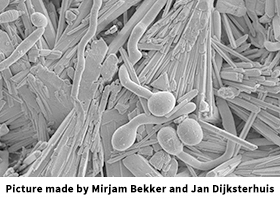- 4.0Impact Factor
- 8.4CiteScore
- 19 daysTime to First Decision
Fungi in Indoor Environments
This special issue belongs to the section “Environmental and Ecological Interactions of Fungi“.
Special Issue Information
Dear Colleagues,
Filamentous fungi, also known as molds, occur in many indoor environments. Water is an absolute requirement for fungal growth. The indoor environment is highly complex and dynamic in this respect. This is caused by varying occupants’ activities, such as showering and cooking. Further, the use of air diffusers, window gaps, air-conditioners, etc. introduce variations in air movement and humidity. Different types of furnished surfaces (e.g., glass, non-treated wood boards, porous gypsum materials) behave differently in their moisture content and water activity, which create micro-environments for fungal development.
In addition, changes in temperature and nutrient availability (which is often scarce) also occur. In laboratory studies, growth conditions are often static in time and include optimal nutrient conditions—this is very different from the conditions that prevail in indoor situations.
Indoor mycology includes the study of the different fungi which are well-adapted to the indoor environment. The topics of interest to this Special Issue include (but are not limited to): 1) adaptation of fungi to indoor conditions; e.g., growth during changes in humidity and survival under more stressful conditions; 2) taxonomy of indoor fungi; 3) (volatile) secondary metabolites including mycotoxins; 4) fungal growth after climate events (tsunamis, hurricanes, and floods); and 5) allergy or other health concerns. We also invite researchers to submit research papers related to topics including physiological, genetic, or molecular mechanisms in the survival of indoor fungi. The aim of this Special Issue is to advance both fundamental and applied research in the field of indoor fungi.
Dr. Jan Dijksterhuis
Dr. Haoxiang Wu
Guest Editors
Manuscript Submission Information
Manuscripts should be submitted online at www.mdpi.com by registering and logging in to this website. Once you are registered, click here to go to the submission form. Manuscripts can be submitted until the deadline. All submissions that pass pre-check are peer-reviewed. Accepted papers will be published continuously in the journal (as soon as accepted) and will be listed together on the special issue website. Research articles, review articles as well as short communications are invited. For planned papers, a title and short abstract (about 250 words) can be sent to the Editorial Office for assessment.
Submitted manuscripts should not have been published previously, nor be under consideration for publication elsewhere (except conference proceedings papers). All manuscripts are thoroughly refereed through a single-blind peer-review process. A guide for authors and other relevant information for submission of manuscripts is available on the Instructions for Authors page. Journal of Fungi is an international peer-reviewed open access monthly journal published by MDPI.
Please visit the Instructions for Authors page before submitting a manuscript. The Article Processing Charge (APC) for publication in this open access journal is 2600 CHF (Swiss Francs). Submitted papers should be well formatted and use good English. Authors may use MDPI's English editing service prior to publication or during author revisions.
Keywords
- indoor fungi
- buildings
- fungal responses
- taxonomy
- health concerns
- genetics
- molecular mechanisms

Benefits of Publishing in a Special Issue
- Ease of navigation: Grouping papers by topic helps scholars navigate broad scope journals more efficiently.
- Greater discoverability: Special Issues support the reach and impact of scientific research. Articles in Special Issues are more discoverable and cited more frequently.
- Expansion of research network: Special Issues facilitate connections among authors, fostering scientific collaborations.
- External promotion: Articles in Special Issues are often promoted through the journal's social media, increasing their visibility.
- e-Book format: Special Issues with more than 10 articles can be published as dedicated e-books, ensuring wide and rapid dissemination.

